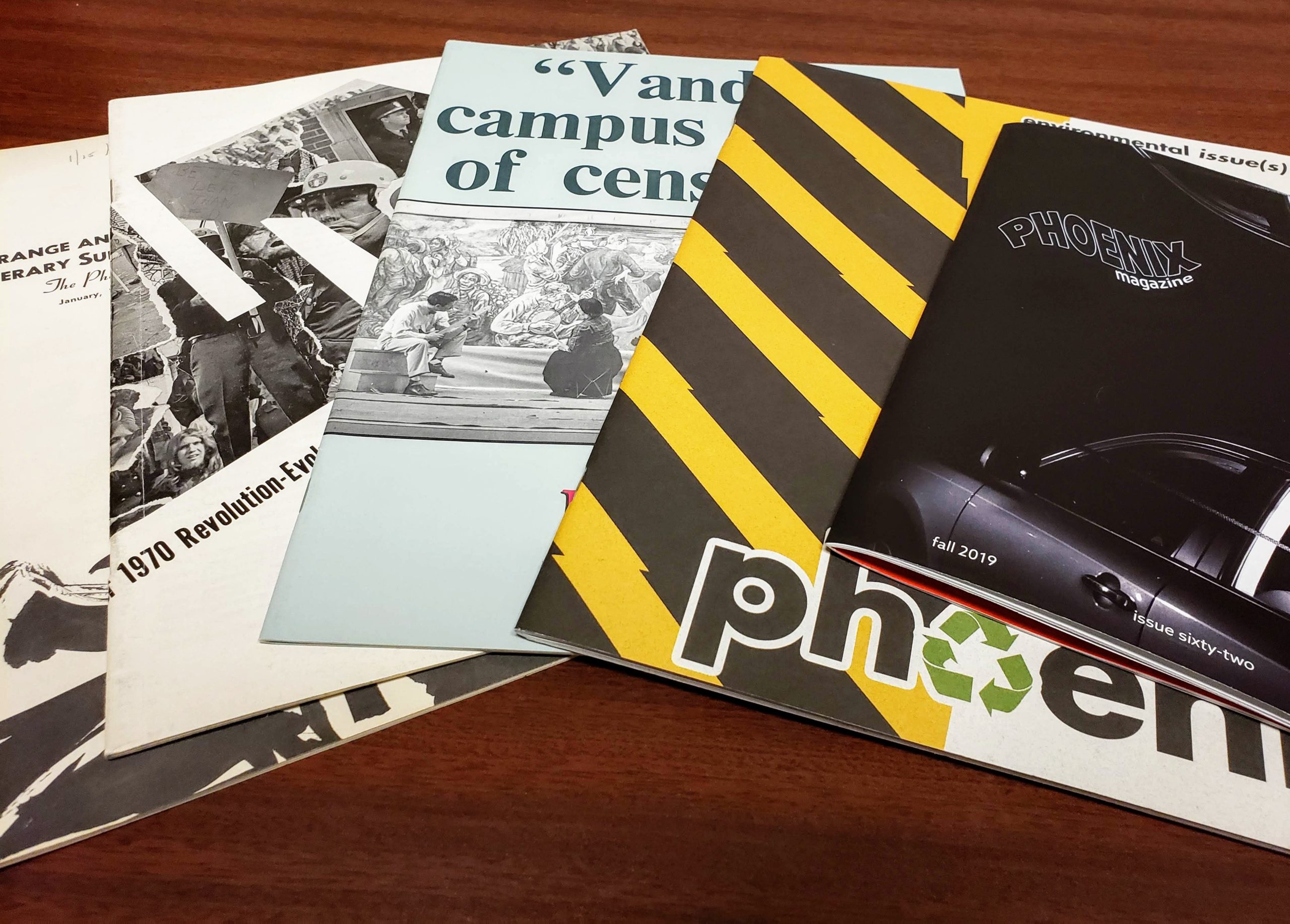By Collin Green
Edited by Ben Hurst
Deep, down on the basement level of the University of Tennessee Communications Building sits an unassuming, single-room office. Clearly meant for a single person, the small L-shaped space is quaint. There are no windows, no open spaces. A small couch, a couple chairs and a tiny knee-high table dominate the small room . Towards the back, a modest desk sits alone piled high with papers, magazines and books, and in the corner a decades-old filing cabinet lingers, gathering dust. It may not look like much, but the tiny office space is home to one of the university’s most esteemed publications: The Phoenix.
Developed within these walls, each issue of the magazine holds a piece of the university’s cultural history. From its first issue in 1959, The Phoenix Literary and Arts Magazine has been a student-led haven for UT’s brightest authors and artists. Now celebrating 60 years in publication, the magazine is known as a home for student artistry on campus. Its history goes far deeper. The Phoenix staff has always sought to provide students with a platform to speak truth to power and share their own stories through art. Today, the publication renews that commitment as it transitions into the new world of print media.
But before The Phoenix became a hub for cultural conversation on campus, the magazine came into being as a supplement to the student newspaper, The Orange and White. Rising from the ashes of the discontinued, student-led literary magazine The Tennessean, The Phoenix has always harbored a commitment to student art and literature.
From the opening pages of its first edition in 1959 to today, the mission has remained the same. “We dedicate the first issue of “The Phoenix” to you, the students and faculty of the University of Tennessee,” the original dedication reads. “Rising from the flame of challenge, ‘The Phoenix’ offers you an opportunity to participate directly in the literary experience as contributors and as readers. Thus we hope to encourage the creation and appreciation of literature and the arts at the university.”
Indeed, the “flame of challenge” would go on to become a prevailing theme for the magazine. Cormac McCarthy, Pulitzer Prize winning author of “The Road” and “No Country for Old Men,” UT alumnus and first contributor to The Phoenix, wrote several stories for the magazine during his stint as a student. Each of his stories were graphic and brooding—precursors to the dark material he would come to be known for.
In 1965, The Phoenix’s first independent issue matched pictures of Bob Dylan alongside an essay analyzing the morality of protest surrounding America’s role in the Vietnam War. Counterculture would go on to be a favorite topic of Phoenix editors during the 1960s and 70s. In ’67, the magazine attempted to investigate student usage of marijuana and lysergic acid diethylamide (LSD) on campus, but the story was dropped after threats of a police raid on staffers’ homes began to surface. In 1967, the publication parodied the Harvard Lampoon, and in 1970, The Phoenix put out a “Revolution-Evolution” edition of the magazine—dedicated to the waves of change in that era.
Largely, the “Revolution-Evolution” was concerned with how America’s music had changed and its effect on society as a whole. The exploration of new American art would set the stage for magazines to come. In ‘88, The Phoenix investigated vandalism, censorship and cultural criticism as places for artistic expression. It has tackled contemporary controversies throughout its lifespan. In 1998, the magazine hoped to bring new understandings of underrepresented cultures to the university. Then, in 2005, The Phoenix dedicated itself to issues concerning the environment.
Telling untold stories seems to be one of Phoenix’s priorities, and that legacy continues today. Recent issues have sought to provide unrepresented peoples with a voice in our increasingly noisy political landscape. Year after year the magazine continues to explore contemporary cultural issues and provide students a place to extend their thoughts without fear of censorship.
“I think that’s what makes it so important,” said former Phoenix Editor-in-Chief Michaela Roach-Ellis. “It’s more of a cultural publication that embodies the student perspective on campus.”
Indeed, the publication is well equipped to serve as broadcast point for the university perspective; the magazine accepts all kinds of work from UT’s students, alumni and faculty.
“It’s a physical and creative representation of student life,” Roach-Ellis said. “We have always had submissions that have a take on taboo or controversial topics—topics people are afraid to touch.”
The recent UT grad said that is exactly where the value of the magazine lies in its promotion of cultural conversation. “We get pieces from all across the board, from every viewpoint, and it is interesting to see work that sometimes challenges one another,” Roach-Ellis said.
Conversation is the only way to curb controversy, the former editor continued. “Even during my two short years as editor-in-chief, there were so many topics and themes that were confronted and addressed,” Roach-Ellis said. Publishing those kinds of things in the magazine, they asserted, “that’s how we start a dialogue.”
Beyond giving them a voice, The Phoenix offers an opportunity for students to publish their work and advance their careers in a collaborative environment controlled by their contemporaries.
“The best thing about the magazine is that it is totally student operated,” said UT Director of Student Media Jerry Bush. “It’s always run that way, student operated, student produced and student content.”
Still, Bush says that it’s hard for magazines like The Phoenix to make it in the increasingly noisy world of modern media. “Sometimes I feel like it’s been forgotten,” he said. “Since print has been dying, how do you remain in front of the student eye?”
No doubt it is difficult. In recent years the magazine has made strides to modernize. In addition to the printed version of the magazine, The Phoenix has launched a website where it publishes stories covering arts, culture and literature surrounding UT. Bush hopes this will help the magazine keep its place in the public eye while making room for new audiences. “Everyone on campus loves to get their hands on that printed version,” Bush said. “But I think the website and being online allows the whole world to see the magazine.”
But even with the uncertainty of modern print media, the student media director maintains that The Phoenix still holds a significant place in the cultural zeitgeist on campus. He hears regularly from groups across campus looking to get their hands on the latest issue. “Being recognized like that, among students and faculty,” he said, “that’s about as good as it gets.”
According to Bush, what keeps the magazine going is the students who run it. For him, the quality of the work produced is a source of pride. “I think that the work generated by students at the University of Tennessee is just as good as the students from any college in the country,” Bush said. “There’s some top-notch stuff that goes into our magazine, and I think it could stand out as one of the best in the country.”
For Roach-Ellis, The Phoenix is more than the quality or recognition, but the impact it has on students’ homes. “People take it, and they recreate it and transform it into something new,” they said. “I feel like that’s changed a lot of lives. Even if it’s in a small way, the magazine has helped a lot of people.”
Of course, looking at the magazine’s tiny office and small staff, it may be easy to underestimate the impact of The Phoenix. But what can’t be underestimated is its legacy. From the very beginning, The Phoenix has stood as a student-driven haven for art, literature and cultural conversation. That history continues today, a burning example of how high UT students can fly.





